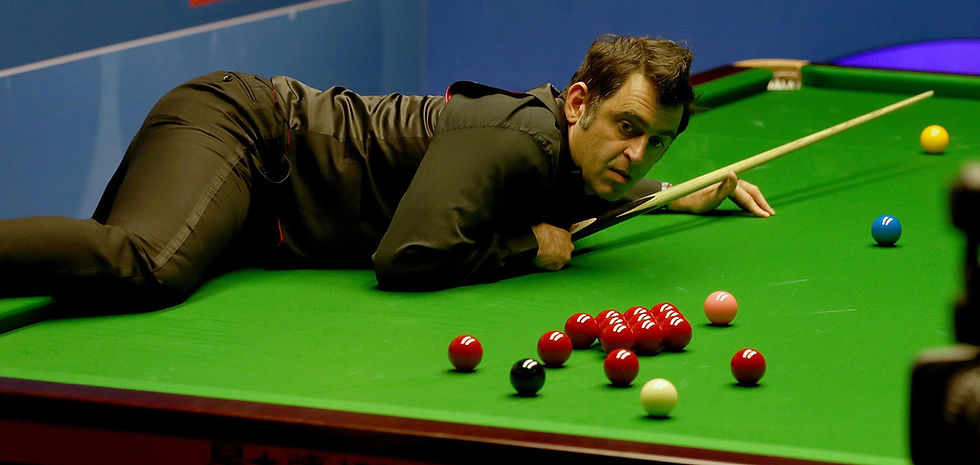Right on cue : The cult of Snooker
- Ben Ansell

- Apr 16, 2018
- 3 min read
Updated: Nov 16, 2020
Snooker is something of a cult sport in Britain and the commonwealth, but where did it come from and why are snooker players the best dressed sportsman on the planet?

In the 80’s and 90’s passing most British homes you would catch a glimpse of a big green table on a screen, a man in a waistcoat, possibly with a bow tie hunched over it, nearby a small table with his cigarette and a pint of warm beer.
Mother India

Snooker, a terribly British sport, was developed in 1884 by Sir Neville Chamberlain whilst serving in the British Army, stationed in Ooty, India. Billiards was already a popular sport amongst members of the military, Sir Chamberlain evolved the concept further by combining rules from pyramid and life pool. The name ‘Snooker’ comes from a military term to describe 'fresh meat' or the new and inexperienced first-year personnel.
The game grew in popularity across India, but it was very much a sport of the ‘upper class’ back home in the United Kingdom. It would be played in high-end Gentleman’s clubs and Gentlemen would remove their jackets to play, playing in just their waistcoats and other dress. The ‘finery’ of the game remained even as it was opened up to the classless. It’s popularity grew further after the formation of the Billiards Association and Control Club (BB&CC) in 1919. Once snooker halls were created, they became havens for the working classes and ‘dodgy’ dealings. It seems the criminal underworld was attracted to the dimly lit rooms, the overhead light throwing shadows where ‘business transactions’ could take place. It became a common haunt of the miscreant, The Krays were big snooker and pool fans, in fact it quickly became a stereotypical setting for gritty gangsters. The low light and ability to smoke whilst playing, as well as having a bar in the same room surely had some influence.
Attenborough – King of colour
The sport experienced it’s major breakthrough in 1969 through the unlikely advocate of Sir David Attenborough who commissioned the snooker tournament ‘Pot Black’ to test the potential of colour television, the green felt table and coloured balls being a perfect opportunity to trial the new technology.
Perhaps it was the colours, perhaps it was the formal dress code, or the strange colonial tone of the sport, whatever the appeal, it rapidly grew in popularity throughout the commonwealth. The World Championship was televised in 1978 and the sport became one of BBC 2’s most viewed programmes, often extending beyond the scheduled broadcast, delaying or postponing a drama or documentary much to the felt ripping chagrin of the uninitiated.
The table through time


Ray Reardon was the heavy contender of the 1970s, Steve Davis in the 1980s, then in the 1990’s Stephen Hendry, a talented and precise player with very little personality almost killed the sport by being stylishlessly proficient. Luckily, the 90’s was a televisual wonderland with the likes of Bullseye presented by the late and great Jim Bowen, pub sports were enormously popular. Big Break presented by Jim Davidson and John Virgo brought a little light entertainment to the big green table. The 90’s was the era of Britpop and in that spirit Ronnie O'Sullivan stepped up to the felt, looking like a long lost Gallagher brother, he injected some ‘lad culture’ into the game. His style was nonchalant and non-committal but he had a raw and visceral talent that allowed him to win the most world titles since 2000.
Snooker sinks the black?
The loss of tobacco sponsorship during the 2000s led to a decrease in the number of professional tournaments and snooker it would seem, slowly became a lost relic of a bygone era. Televised drinking and smoking, although in fine clothing, doesn’t quite fit with the health and safety regulations of ‘current year’. Have we discarded this dusty old colonial sport which courts crime and has no real health benefits? Will the shady characters of the next Guy Pearce film be forced to do their business in the harsh light of the local curling rink?
Well no, thanks to promoter Barry Hearn who took over World Snooker Ltd in 2010. Barry has increased the number of professional tournaments and in 2013 the total prize money more than doubled from £3m to more than £7m. The game has also grown popular in China, where Liang Wenbo has been clearing up the tables and drawing a new generation to the sport.
Snooker is rebounding and with it’s return we see the unlikely comeback of one of it’s biggest losers, the ‘People’s Champion’ Jimmy ‘the whirlwind’ White. One of the unluckiest contesters in one of Britain’s most British sports. Happy 134th Birthday Snooker!





Comments